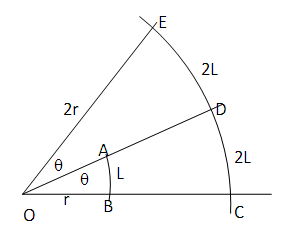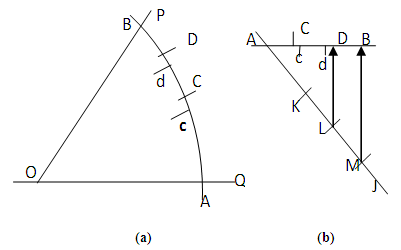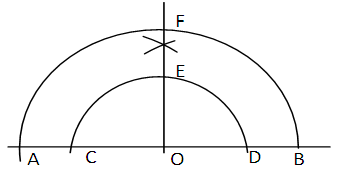-
Paper Information
- Paper Submission
-
Journal Information
- About This Journal
- Editorial Board
- Current Issue
- Archive
- Author Guidelines
- Contact Us
Applied Mathematics
p-ISSN: 2163-1409 e-ISSN: 2163-1425
2015; 5(4): 84-87
doi:10.5923/j.am.20150504.02
Equipartition of Plane Geometric Angle into any Number of Parts
Ohochuku N. Stephen
Department of Chemistry, Ignatius Ajuru University of Education, Rivers State, Nigeria
Correspondence to: Ohochuku N. Stephen, Department of Chemistry, Ignatius Ajuru University of Education, Rivers State, Nigeria.
| Email: |  |
Copyright © 2015 Scientific & Academic Publishing. All Rights Reserved.
The introduction of plane geometry in post primary schools includes among others the division of plane angles. Bisection method is the only method taught for this operation which divides angles into 2n (n is an integer) or 2, 4, 8 etc equal parts to utter exclusion of 3, 5, 6, 7, 9 etc equal parts. This paper introduces two methods that divide any angle into any number of equal parts by converting the angle into a sector, dividing the sector arc into the desired number of equal arcs hence into a number of small equal sectors with equal angles summing up to the main sector angle. The methods apply known facts of plane geometry. It is accurate, simple and is recommended to be incorporated into the teaching and learning in this aspect of basic study of plane geometry.
Keywords: Equipartition, Angles, Geometry, Equal division of plane angles into many parts
Cite this paper: Ohochuku N. Stephen, Equipartition of Plane Geometric Angle into any Number of Parts, Applied Mathematics, Vol. 5 No. 4, 2015, pp. 84-87. doi: 10.5923/j.am.20150504.02.
Article Outline
1. Introduction
- Bisection of plane geometric angles is the only procedure taught for the division of angles in introductory plane geometry and there are text books [1-5] dealing on this subject matter. This routine method has continued to dominate the scene despite the fact that it divides angles only into 2, 4, 8 etc excluding 3, 5, 6, 7, 9 etc equal parts. This could be caused by the absence of other simple methods or that some angles that cannot be obtained through bisection can be copied from the protractor or the use of set squares. The method by Givens [6] is mathematically complex, tedious and cannot be practiced by High School students. There is therefore the need for other methods to be introduced. The main aim of this article is to introduce other methods that equally partition any plane angle into a number of parts and in addition to highlight some other applications of the result of these methods.
2. Methodology
2.1. Basic Principles of the New Methods
- The new methods utilize the following principles of plane geometry. The arc length l of arc AB of a sector AOB (or circle) of radius r subtends a definite angle θo at the centre O, figure 1. Also at constant angle θo the arc length l of AB increases in the same proportion as the radius increases. Follow up of these are that for the concentric arcs AB (radius r) and arc CD (radius 2r), figure 1, arc length CD is twice arc length AB. All these are derivable from the equation arc length l = 2πrθ/360.
 | Figure 1. Relationship between θ, arc length and radius |
 | Figure 2. Relationship between arc length and radius |
2.2. Partitioning of Arc Length of an Angle
- (a). Applying direct variation of Arc Length with its RadiusAs arc length increases in direct proportion as its radius, the radius R of the sector will be divided into n equal parts so R equals nr and r is the radius of the least concentric arc.The sector arc can now be partitioned into n parts by dividing it by the arc length of the smallest arc. Each of the small arcs from the division will subtend at the center θ°/n. In practice it is found that it is better to use half (or twice this half) the arc length of the least arc. So the sector angle or the least arc is bisected. The detailed steps are as listed in section 2.2a. 2.2a Equal Division of Angle applying direct variation of Arc Length with its Radius: ProcedureTo divide an angle, say 60o into five equal parts.a) Draw or construct ∠POQ = 60°, figure 3. b) From O with any convenient radius cut along OQ such that OC = CD = DE = EF = FB.c) O as centre, radius OC swing arc CG and O as centre and radius OB swing arc BA. The angle is converted to a sector AOB.d) Let OR be the bisector of angle AOB.e) B as starting point divide arc BA by arc lengths CH + HG
 | Figure 3. Equal division of an angle, say 60°, into five parts |
 | Figure 4. Trisection of 60o by the second Method |
2.3. Other Applications of the New Method
- Givens [6] in his paper observed that angle trisection and in fact division of angles into equal number of parts is of very great importance because of the wider use which may be made of the knowledge. Here under are some of the applications. Once an angle is divided into a number of equal parts, new angles can be constructed either by adding or subtracting one part of the quotient as illustrated below. An angle can also be divided into a ratio. In most cases a simple arithmetic, as shown in 2.3.1 to 2.3.3, is needed. Calculations for some other angles are shown in Table 1.
2.3.1. To Construct 72°
- Needed calculation is: 72 = 60 + 12 = 60 + 60/5.So construct or draw angle 60° figure 3, divide it into five equal parts as in 2.2a,b and add a sector of 12° to sector of angle 60°. The addition goes thus: A as centre, radius AM cut arc BA produced at N, ∠NOB = 72°.
2.3.2. To Construct Angle 48o
- Similarly 48 = 60 – 12 = 60 - 60/5.This means discarding the ∠BOJ or ∠AOM = 12° sector, figure 3. Discarding ∠AOM leaves ∠MOB = 48°.
2.3.3. To divide an Angle into a Given Ratio e.g. 2:3.
- Sum of ratio is five. Still on figure 3 as example, the angle is divided into five. Combining the last two sectors each of 12° gives a sector AOL of 24°; the first three sectors form a sector BOL of angle 36°. The ratio is 2:3.
3. Results and Discussion
3.1. Basic Principles of the New Methods
- The direct proportionality of arc length to radius at constant angle and of arc length to angle at constant radius are known facts in plane geometry. Therefore the sector arc length will increase integrally as the radius integrally increases. The division of the radius of the sector into equal parts is to have any arc length with any of these radii a multiple of the length of the least arc. This makes it possible to divide the sector arc into the desired number of small arcs and also the sector angle into the desired number of parts. The length of any arc having any of these radii and is concentric with the sector arc will be an integral multiple of the least arc. Arc lengths of succeeding arcs will thus increase as multiples of the least arc length. The divisor CH (or CH + HG) is the chord of the arc CH (or CH and HG) and not half of chord CG. Also the sum of chord CH and chord HG is greater than chord CG. When bisected, it is chords CH and HG (actually the arcs) that subtend equal angles at O. Fig 5 shows that chords CE + ED (arcs CE + ED) not chord COD equals chord BF (or arc BF). The line bisector of the sector angle not only provides the divisor but also acts as a check to know whether the centre of each arc lies on it.
 | Figure 5. Bisection of angle 180o by the new method |
 | Figure 6. Comparison of Equal Division (e.g. trisection) of a Straight Line and also an Angle |
3.2. Other Applications of the New Methods
- The construction of angles by the new methods through the addition or subtraction procedure is straight forward and must be carried out in a sector of same radius since it is a section of the arc length of the main sector that is involved. A change in radius gives wrong result. Addition and subtraction of angles and also division of angles into ratio parts are possible in bisection method but the angle(s) to be added or subtracted or expressed as ratio parts are those angles that can be obtained from bisection. For example 75° = 60° + 15°. 15° can be obtained from bisecting 60o and the resulting 30°. Splitting 60° into 20° and 40° (i.e. 1:2 ratio) is not possible through bisection as neither 20° nor 40° can be constructed by bisection unless by the equipartition procedures. The new methods coupled with the routine method of constructing and bisecting angles make it possible to construct such angles like 10°, 12°, 40°, 72°, 108° to mention a few. By combining the routine method with the new methods regular polygons of base angles 108°, (exterior angle 72°) and 12844/7o (exterior angle 513/7o) and others, see Table 1, can be constructed if the length of its side is known and the base angle or the exterior angle can be easily constructed.
|
4. Conclusions
- The new procedures are easy and versatile and when coupled with existing routine methods more difficult constructions can be done. The new methods should be incorporated in the teaching of basic angle construction in plane geometry.
 Abstract
Abstract Reference
Reference Full-Text PDF
Full-Text PDF Full-text HTML
Full-text HTML